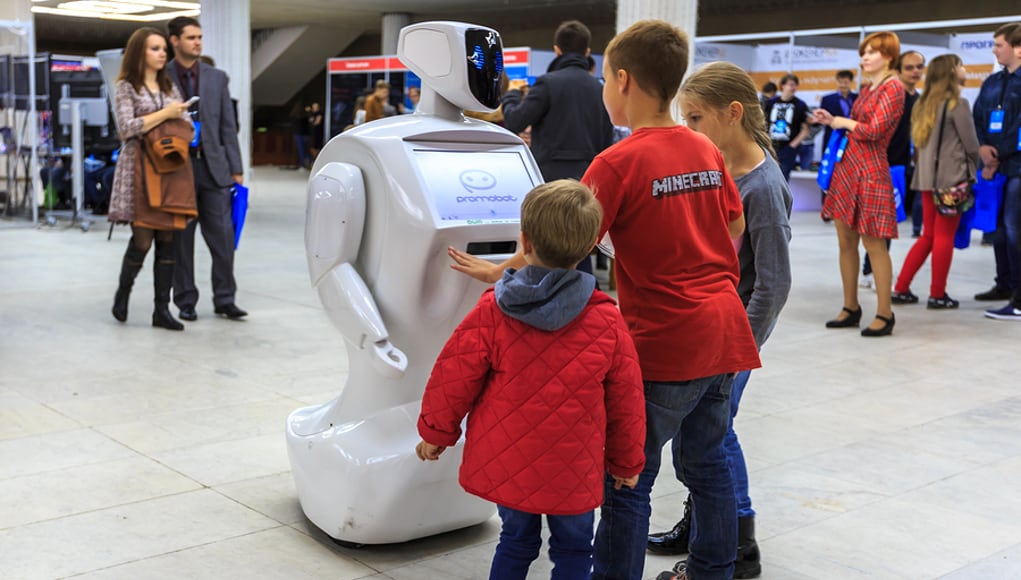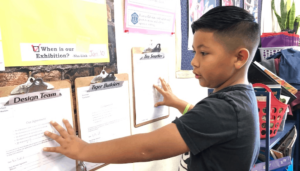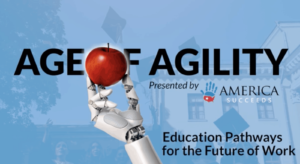Now That We’re Augmented, What Should We Learn?

Code that learns is reshaping life and work on planet earth–and it is doing so at an unprecedented speed. We’re a couple years into something new and different, a new era–one that follows the information age.
In this new age, almost every job has been augmented with smart machines. Some jobs are going away. Entrepreneurs will create lots of new jobs. In the past, revolutions would last a century, but now they last a generation–and this one’s just getting started.
As discussed at CoSN last week, the World Economic Forum calls this shift the Fourth Industrial Revolution (the first three were driven by steam power, electricity, and the Internet). This one is powered by artificial intelligence, fed by data from the exploding Internet of Things, and equipped by a growing army of robots.
What Grads Should Know
This new era is making new economic, ethical and educational demands. Like Battelle for Kids, America Succeeds, KnowledgeWorks and others, we think it’s a good time to have a community conversation about what graduates should know and be able to do. We appreciate frameworks that recognize new priorities like wayfinding ability (MyWays from NGLC) and being generous collaborators (XQ Institute).
In this new innovation age where we are all partners with smart machines, we see three new developmental priorities including:
- Confidence in the face of complexity: a structured approach to problem-solving when facing adaptive challenges (often called design thinking or computational thinking) with some pattern recognition based on prior successes in a variety of contexts.
- The self-management, social awareness, and relational skills (often called social and emotional learning) to manage projects and deliver value.
- A mindset of growth (effort matters) and entrepreneurship (initiative matters) is key to contribution. Whether freelancing or working for an employer, the ability to frame, construct, and carry out new value producing initiatives is critical.
On Learner Experience (What School Could Be)
To flex these new muscles, learners need extended challenges — big integrated projects — that require initiative, design skills, collaboration, and public products. A growing coalition of schools calls this High Quality Project Based Learning (HQPBL).
New tools make it possible to accelerate skill development and personalize learning journeys for every student. Students can progress as they demonstrate mastery. The best resource for student-centered competency-based learning is CompetencyWorks, a project of iNACOL.
Students learn problem-solving and critical thinking through real-world design challenges. Instead of a traditional schedule, teachers and students work together to outline time for individual learning, group instruction, and project-based works. Students become responsible for identifying gaps in their own knowledge, and receive support where and when they need it.
Learners need space to ask big questions, try new things, and to create. It is more important than ever to help students build confidence by experiencing success in a variety of settings — in problem-solving, in the sciences, in work settings, in publication, and in the performing arts. We’re excited about expanding learning beyond the school and utilizing the city as the classroom.
For a picture of next-generation learning, visit new schools like One Stone in Boise and Purdue Polytechnic in West Lafayette, Indiana. These student-centered schools engage students in meaningful work and chart progress against broader outcomes. They are competency-based, but more interested in cultivating gifts, nurturing passions, and identifying contribution opportunities than a skills checklist.
A New High School Credential
We need a new high school credentialing system that conveys specific competencies and accomplishments to employers and postsecondary institutions, a system that is flexible and modular enough to works across different career pathways, and a credentialing system that allows learners to move through the system as they demonstrate mastery.
A new mastery transcript will become the interface between high school and postsecondary learning opportunities. It will communicate competencies rather than credits and will include evidence of success. While these new transcripts will be shared through distributed ledger technologies (blockchain), comprehensive learner profiles will probably be managed locally off-chain.
This new evidence-based diploma will enable networks of schools that share learner outcomes, experiences (what we used to call courses), evidence of learning (what we used to call assessments), tools, and supports. Eventually, states may stop testing kids and start certifying networks.
What’s Next?
We’re excited about the potential of:
- School models that support sustained adult relationships and robust advisory systems;
- Equitable access to powerful work and community-based learning experiences;
- The potential of augmented and mixed reality to extend the power of place-based learning (e.g., the ability to walk around the block and visualize data sets associated with ecology, demographics, and economics);
- Microcredentials to transform progressional learning and how smart tools will improve talent development services; and
- Learning spaces that inspire and support powerful learning.
We’re excited that more young people are gaining access to deeper learning experiences. We know it can be challenging to support the experiences, whether a challenge politically, technologically, or financially. Better local, state, and federal policy is also part of the solution. Working together in networks is part of the solution. Trying something new and different that inspires powerful learning next week is part of the solution.
For more, see:
- Ask About AI: The Future of Learning and Work (our recent report)
- The Future of Learning Is…
- 15 Elements of Next-Gen Learner Experiences
Stay in-the-know with all things EdTech and innovations in learning by signing up to receive the weekly Smart Update. This post includes mentions of a Getting Smart partner. For a full list of partners, affiliate organizations and all other disclosures, please see our Partner page.








Patti Shade
Creativity skillsets and mindsets get nicely within the 3 new developmental priorities: Design Thinking, Social/Emotional Learning and Entrepreneurship!